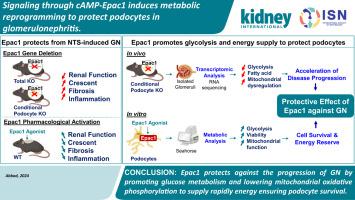当前位置:
X-MOL 学术
›
Kidney Int.
›
论文详情
Our official English website, www.x-mol.net, welcomes your feedback! (Note: you will need to create a separate account there.)
Signaling through cAMP-Epac1 induces metabolic reprogramming to protect podocytes in glomerulonephritis
Kidney International ( IF 14.8 ) Pub Date : 2024-05-29 , DOI: 10.1016/j.kint.2024.05.010 Lilia Abbad , Maximin Détrait , Panagiotis Kavvadas , Dorian Bergonnier , Lisa Melis , Marion Laudette , Tiffany Migeon , Marie-Christine Verpont , Alexandre Lucas , Christos Chatziantoniou , Frank Lezoualc’h
Kidney International ( IF 14.8 ) Pub Date : 2024-05-29 , DOI: 10.1016/j.kint.2024.05.010 Lilia Abbad , Maximin Détrait , Panagiotis Kavvadas , Dorian Bergonnier , Lisa Melis , Marion Laudette , Tiffany Migeon , Marie-Christine Verpont , Alexandre Lucas , Christos Chatziantoniou , Frank Lezoualc’h

|
Unlike classical protein kinase A, with separate catalytic and regulatory subunits, EPACs are single chain multi-domain proteins containing both catalytic and regulatory elements. The importance of cAMP-Epac-signaling as an energy provider has emerged over the last years. However, little is known about Epac1 signaling in chronic kidney disease. Here, we examined the role of Epac1 during the progression of glomerulonephritis (GN). We first observed that total genetic deletion of Epac1 in mice accelerated the progression of nephrotoxic serum (NTS)–induced GN. Next, mice with podocyte-specific conditional deletion of Epac1 were generated and showed that NTS-induced GN was exacerbated in these mice. Gene expression analysis in glomeruli at the early and late phases of GN showed that deletion of Epac1 in podocytes was associated with major alterations in mitochondrial and metabolic processes and significant dysregulation of the glycolysis pathway. , Epac1 activation in a human podocyte cell line increased mitochondrial function to cope with the extra energy demand under conditions of stress. Furthermore, Epac1-induced glycolysis and lactate production improved podocyte viability. To verify the therapeutic potential of Epac1 activation, the Epac1 selective cAMP mimetic 8-pCPT was administered in wild type mice after induction of GN. 8-pCPT alleviated the progression of GN by improving kidney function with decreased structural injury with decreased crescent formation and kidney inflammation. Importantly, 8-pCPT had no beneficial effect in mice with Epac1 deletion in podocytes. Thus, our data suggest that Epac1 activation is an essential protective mechanism in GN by reprogramming podocyte metabolism. Hence, targeting Epac1 activation could represent a potential therapeutic approach.
中文翻译:

通过 cAMP-Epac1 的信号传导诱导代谢重编程以保护肾小球肾炎中的足细胞
与具有独立催化和调节亚基的经典蛋白激酶 A 不同,EPAC 是包含催化和调节元件的单链多结构域蛋白。 cAMP-Epac 信号作为能量提供者的重要性在过去几年中已经显现出来。然而,人们对慢性肾病中的 Epac1 信号传导知之甚少。在这里,我们研究了 Epac1 在肾小球肾炎 (GN) 进展过程中的作用。我们首先观察到小鼠中 Epac1 的完全基因缺失加速了肾毒性血清 (NTS) 诱导的 GN 的进展。接下来,生成了足细胞特异性条件性删除 Epac1 的小鼠,结果表明 NTS 诱导的 GN 在这些小鼠中加剧。 GN 早期和晚期肾小球的基因表达分析表明,足细胞中 Epac1 的缺失与线粒体和代谢过程的重大改变以及糖酵解途径的显着失调相关。人类足细胞系中 Epac1 的激活增强了线粒体功能,以应对压力条件下额外的能量需求。此外,Epac1 诱导的糖酵解和乳酸生成提高了足细胞的活力。为了验证 Epac1 激活的治疗潜力,在诱导 GN 后,对野生型小鼠施用 Epac1 选择性 cAMP 模拟物 8-pCPT。 8-pCPT 通过改善肾功能、减少结构损伤、减少新月体形成和肾脏炎症来减轻肾小球肾炎的进展。重要的是,8-pCPT 对足细胞 Epac1 缺失的小鼠没有有益作用。因此,我们的数据表明 Epac1 激活是 GN 中通过重编程足细胞代谢的重要保护机制。 因此,针对 Epac1 激活可能代表一种潜在的治疗方法。
更新日期:2024-05-29
中文翻译:

通过 cAMP-Epac1 的信号传导诱导代谢重编程以保护肾小球肾炎中的足细胞
与具有独立催化和调节亚基的经典蛋白激酶 A 不同,EPAC 是包含催化和调节元件的单链多结构域蛋白。 cAMP-Epac 信号作为能量提供者的重要性在过去几年中已经显现出来。然而,人们对慢性肾病中的 Epac1 信号传导知之甚少。在这里,我们研究了 Epac1 在肾小球肾炎 (GN) 进展过程中的作用。我们首先观察到小鼠中 Epac1 的完全基因缺失加速了肾毒性血清 (NTS) 诱导的 GN 的进展。接下来,生成了足细胞特异性条件性删除 Epac1 的小鼠,结果表明 NTS 诱导的 GN 在这些小鼠中加剧。 GN 早期和晚期肾小球的基因表达分析表明,足细胞中 Epac1 的缺失与线粒体和代谢过程的重大改变以及糖酵解途径的显着失调相关。人类足细胞系中 Epac1 的激活增强了线粒体功能,以应对压力条件下额外的能量需求。此外,Epac1 诱导的糖酵解和乳酸生成提高了足细胞的活力。为了验证 Epac1 激活的治疗潜力,在诱导 GN 后,对野生型小鼠施用 Epac1 选择性 cAMP 模拟物 8-pCPT。 8-pCPT 通过改善肾功能、减少结构损伤、减少新月体形成和肾脏炎症来减轻肾小球肾炎的进展。重要的是,8-pCPT 对足细胞 Epac1 缺失的小鼠没有有益作用。因此,我们的数据表明 Epac1 激活是 GN 中通过重编程足细胞代谢的重要保护机制。 因此,针对 Epac1 激活可能代表一种潜在的治疗方法。











































 京公网安备 11010802027423号
京公网安备 11010802027423号